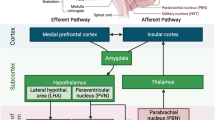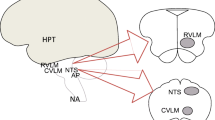Abstract
I am honored by the invitation to contribute to a volume in Neuroscience, dedicated to Professor Galoyan, whose accomplishments in the field of neuroscience and circulation have been unique. In his book, Dr. Galoyan has summarized the results of his discovery of cardioactive neurohormones. His discovery of biosynthesis of cytokines in the neurosecretory cells of the hypothalamus have opened a new page in immunology.
Similar content being viewed by others
REFERENCES
Lowenstein, C. J., Dinerman, J. L., and Snyder, Solomon H. 1994. Nitric Oxide: A Physiologic Messenger. Ann Intern Med. 120(3):227-237.
Bredt, D. S., Hwang, P. M., and Snyder, S. H. 1990. Localization of nitric oxide synthase indicating a neural role for nitric oxide. Nature. 347:768-70.
Bing, R. J., and Suzuki, H. 1996. Myocardial infarction and nitric oxide. Mol Cel Biochem. 160/161:303-306.
Yang, X., Chowdhury, N., Cai, B., Marboe, C., Sciacca, R. R., Michler, R. E., and Cannon, P. J. 1994. Induction of myocardial nitric oxide synthase by cardiac allograft rejection. J Clin Invest. 94:714-721.
DeBelder, A. J., Radomski, M. S., Why, H. J. F., Richardson P. J., Bucknall, C. A., Salas, E., Martin, J. F., and Moncada, S. 1993. Nitric oxide synthase in human myocardium. Lancet. 341:84-85.
Schulz, R., Nava, E., and Moncada, S. 1992. Induction and potential biological relevance of Ca2+-independent nitric oxide synthase in the myocardium. Br J Pharmacol. 105:575-580.
Akiyama, K., Suzuki, P., Grant, P., and Bing, R. J. 1997. Oxidation products of Nitric Oxide, NO2 and NO3, in plasma after experimental myocardial infarction. J Mol Cell Cardiol. 29:1-9.
Wennmalm, A., Benthin, G., Edlund, A., Jungersten, L., Kieler-Jensen, N., Lundin, S., Westfelt, U. N., Petersson, A., and Waagstein, F. 1993. Metabolism and excretion of nitric oxide in humans. Circ Res. 73(6):1121-1127.
Dudek, R., Wildhirt, S., Conforto, A., Pinto, V., Suzuki, H., Winder, S., and Bing, R. J. 1994. Inducible nitric oxide synthase activity in myocardium after myocardial infarction in rabbit. Biochem Biophys Res Commun. 205(3):1671-1680.
Dudek, R., Wildhirt, S., Pinto, V., Giesler, G., and Bing, R. J. 1994. Dexamethasone inhibits the expression of an inducible nitric oxide synthase in infarcted rabbit myocardium. Biochem Biophys Res Commun. 202:1120-1126.
Kimura, A., Roseto, J., Suh, K., and Bing, R. J. 1998. Dexamethasone on inducible nitric oxide synthase and nitrite/nitrate production in myocardial infarction. Proc Soc Exp Biol Med. (in press)
Akiyama, K. Suzuki, H., Takeyama, Y., Gluckman, T., Terhakopian, A., Katagiri, T., and Bing, R. J. 1998. Production of oxidative products of nitric oxide in infarcted human heart. JACC. 32(2). (in press)
Winlaw, D. S., Smythe, G. A., Keogh, A. M., Schyvens, C. G., Spratt, P. M., and Macdonald, P. S. 1994. Increased nitric oxide production in heart failure. Lancet. 344:373-374.
Haywood, G., Tsao, P., Von Der Leyen, H., et al. 1996. Expression of inducible nitric oxide synthase in human heart failure. Circulation. 93:1087-1094.
Langrehr, J. M., Murase, N., Markus, P. M., et al. 1992. Nitric oxide production in host-versus-graft and graft-versus-host reactions in the rat. J Clin Invest. 90:679-683.
Kwon, G., Hill, J. R., Corbett, J. A., and McDaniel, M. L. 1997. Effects of aspirin on nitric oxide formation and de novo protein synthesis by RINm5F cells and rat islets. Mol Pharmacol. 52:398-405.
Amin, A. R., Vyas, P., Attur, M., Leszczynska-Piziak, J., Patel, I. R., Weissmann, G., and Abramson, S. B. 1995. The mode of action of aspirin-like drugs: effect on inducible nitric oxide synthase. Proc Natl Acad Sci USA. 92:7926-7930.
Kopp, E., and Ghosh, S. 1994. Inhibition of NF-κB by sodium salicylate and aspirin. Science. 265: 956-959.
Kepka-Lenhart, D., Chen, L., and Morris, S. M. 1996. Novel actions of aspirin and sodium salicylate: discordant effects on nitric oxide synthesis and induction of nitric oxide synthase mRNA in a murine macrophage cell line. J Leukoc Biol. 59:840-846.
Kimura, A., Roseto, J., Suh, K., Cohen, A. M., and Bing, R. J. 1998. Effect of acetylsalicylic acid on nitric oxide production in infarcted heart in situ. NO: Biol Chem. (in press)
Chen, L., Salafranca, M. N., and Metha, J. 1997. Cyclooxygenase inhibition decreases nitric oxide synthase activity in human platelets. Am J Physiol. 273:H1854-H1859.
Kanematsu, M., Ikeda, K., and Yamada, Y. 1997. Interaction between nitric oxide synthase and cyclooxygenase pathways in osteoblastic MC3T3-E1 cells. J Bone Min Res. 12:1789-1796.
Farivar, R. S., Chobanian, A. V., and Brecher, P. 1996. Salicylate or aspirin inhibits the induction of the inducible nitric oxide synthase in rat cardiac fibroblasts. Circ Res. 78:759-768.
Aeberhard, E. E., Henderson, S. A., Arabolos, N. S., Griscavage, J. M., Castro, F. E., Barerett, C. T., and Ignarro, L. J. 1995. Nonsteroidal anti-inflammatory drugs inhibit expression of the inducible nitric oxide synthase gene. Biochem Biophys Res Comm. 208:1053-1059.
Bonow, R. O., Lipson, L. C., Sheehan, F. H., Capurro, N. L., Isner, J. M., Roberts, W. C., Goldstein, R. E., and Epstein, S. E. 1981. Lack of effect of aspirin on myocardial infarct size in the dog. Am J Cardiol. 47:258-264.
Schoemaker, R. G., Saxena, P. R., and Kalkman, E. A. J. 1998. Low-dose aspirin improves in vivo hemodynamics in conscious, chronically infarcted rats. Cardiovas Res. 37:108-114.
Woolfson, R. G., Patel, V. C., Neild, G. H., and Yellon, D. M. 1995. Inhibition of nitric oxide synthesis reduces infarct size by an adenosine-dependent mechanism. Circulation. 91:1545-1551.
Node, K., Kitakaze, M., Kosaka, H., Komamura, K., Minamino, T., Inoue, M., Tada, M., Hori, M., and Kamada, T. 1996. Increased release of NO during ischemia reduces myocardial contractility and improves metabolic dysfunction. Circulation. 93:356-364.
Pabla, R., and Curtis, M. J. 1995. Effects of NO modulation on cardiac arrhythmias in the rat isolated heart. Circ Res. 77:984-992.
Richard, V., Blanc, T., Kaeffer, N., Tron, C., and Thuillez, C. 1995. Myocardial and coronary endolthelial protective effects of acetylcholine after myocardial ischaemia and reperfusion in rats: role of nitric oxide. Br J Pharmacol. 115:1532-1538.
Kita, Y., Sugimoto, T., Hirasawa, Y., Yoshida, K., and Maeda, K. 1994. Close correlation of the cardioprotective effect of FK409, a spontaneous NO releaser, with an increase in plasma cyclic GMP level. Br J Pharmacol. 113:5-6.
Author information
Authors and Affiliations
Rights and permissions
About this article
Cite this article
Bing, R.J., Cohen, A.M. Biochemistry of the Infarcted Heart. Neurochem Res 24, 1143–1145 (1999). https://doi.org/10.1023/A:1020712520391
Issue Date:
DOI: https://doi.org/10.1023/A:1020712520391




